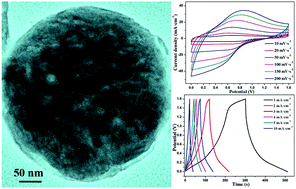Three-dimensional porous V2O5 hierarchical spheres as a battery-type electrode for a hybrid supercapacitor with excellent charge storage performance†
Abstract
Three-dimensional porous V2O5 hierarchical spheres composed of stacked platelets were fabricated by a facile, low-cost and template-free method. The synthetic route involved precipitation of precursor microspheres in aqueous solution at room temperature and subsequent calcination. Various techniques including XRD, FE-SEM, TEM, EDS, IR, Raman and nitrogen adsorption–desorption isotherms were used to reveal the composition, morphology and structure of the as-obtained porous V2O5 hierarchical spheres. The BET specific surface area of V2O5 hierarchical spheres measured 14 m2·g−1 and their average pore size reached 18.2 nm, and a majority of pores in the hierarchical structures were mesoporous. Electrochemical properties of the as-obtained three-dimensional porous V2O5 hierarchical spheres as a battery-type electrode were investigated by cyclic voltammetry (CV), galvanostatic charge–discharge (GCD) and electrochemical impedance spectroscopy (EIS). The hierarchical spheres displayed excellent rate capability and an excellent capacity up to 473 C·g−1 at 0.2 A·g−1 owing to their high ion transfer speed that transpired between electrolytes and active electrode materials. A flexible hybrid supercapacitor (HSC) device was fabricated using the as-obtained three-dimensional porous V2O5 hierarchical spheres as a cathode and activated carbon as an anode and delivered an excellent capacitance of 0.26 F cm−2 at 10 mV s−1. The good electrochemical performance of the porous V2O5 hierarchical spheres indicates their high potential as a battery-type electrode material for the HSC device.



 Please wait while we load your content...
Please wait while we load your content...